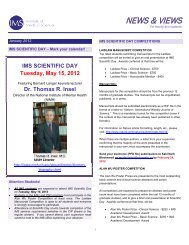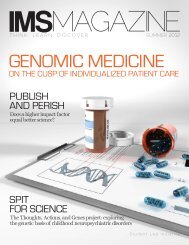Fall 2011 - Institute of Medical Science - University of Toronto
Fall 2011 - Institute of Medical Science - University of Toronto
Fall 2011 - Institute of Medical Science - University of Toronto
You also want an ePaper? Increase the reach of your titles
YUMPU automatically turns print PDFs into web optimized ePapers that Google loves.
FEATURE<br />
Pick Your Brain...<br />
A column by Aaron Kucyi<br />
Chronic prostatitis is a disorder that occurs in<br />
5-10% <strong>of</strong> men and is associated with pain <strong>of</strong> the<br />
prostate and surrounding areas. Also known as<br />
chronic pelvic pain syndrome (CPPS), the disorder<br />
is unrelated to prostate cancer, and its cause is<br />
uncertain. Most research on CPPS has focused<br />
on factors such as inflammation, endocrine involvement,<br />
and pelvic floor muscle abnormalities.<br />
However, spontaneous pain perception in<br />
CPPS is ultimately a result <strong>of</strong> brain activity – an<br />
underexplored phenomenon that was recently<br />
investigated for the first time by researchers at<br />
Northwestern <strong>University</strong>.<br />
In an MRI study <strong>of</strong> a group <strong>of</strong> 19 male CPPS patients,<br />
activity in the right anterior insula (a painrelated<br />
brain region) was associated with fluctuations<br />
in the intensity <strong>of</strong> spontaneous pain over<br />
time. In terms <strong>of</strong> brain structure, there were no differences<br />
in total volume or volume <strong>of</strong> pain-related<br />
regions between patients and healthy controls.<br />
However, higher gray matter density in the right<br />
anterior insula was associated with higher overall<br />
pain experienced by a patient. Also, the relationship<br />
between brain gray matter (neuronal cell<br />
bodies) and white matter (axonal tracts) was disrupted<br />
in patients relative to controls. The neural<br />
changes in CPPS are both similar and unique from<br />
other chronic pain disorders. As CPPS is poorly understood<br />
and difficult to treat, this work provides<br />
important insights that can open up new directions<br />
for research on the mechanisms underlying the<br />
disorder, and potentially pain management.<br />
Reference:<br />
Farmer MA, Chanda ML, Parks EL, Baliki MN, Apkarian AV,<br />
Schaeffer AJ (<strong>2011</strong>) Brain functional and anatomical changes<br />
in chronic prostatitis/chronic pelvic pain syndrome. J Urol<br />
186:117-124.<br />
allow them an opportunity to monitor the<br />
disease through regular follow up appointments.<br />
Curative therapies are recommended<br />
if the preceding criteria advance to indicate<br />
grade progression or volume progression.<br />
Follow up is important. At enrolment, men<br />
have their PSA measured and undergo a digital<br />
rectal exam (DRE). PSA values are drawn<br />
and DREs undertaken every 3 and 6 months,<br />
respectively, for the first two years. A confirmatory<br />
biopsy will also be scheduled within<br />
the first year after diagnosis to ensure that a<br />
more high-risk tumour was not missed. After<br />
the first two years, individuals undergo<br />
PSA measurements every six months and<br />
DREs annually, as well as re-biopsy every two<br />
to three years. Patients will remain on this<br />
schedule <strong>of</strong> care indefinitely unless there is<br />
tumour grade progression. At this point, radiation<br />
therapy or surgical excision with curative<br />
intent will be scheduled, although this<br />
is necessary only for a minority <strong>of</strong> patients.<br />
A rapid rise in PSA, particularly a PSA doubling<br />
time faster than 3 years, should necessitate<br />
a repeat biopsy or multiparametric MR<br />
imaging. Importantly, patients that progress<br />
to high-risk disease appear no more likely to<br />
die than patients who were treated radically<br />
at the outset <strong>of</strong> their diagnosis 2 . Why should<br />
a prostate cancer patient with low-risk disease<br />
opt for active surveillance over radical<br />
treatment? Firstly, prostate cancer is very<br />
common: Roughly 1 in 7 men will be diagnosed<br />
with prostate cancer during their life 1 ,<br />
although many <strong>of</strong> these men harbour clinically<br />
insignificant disease. Perhaps more surprising<br />
is that upwards <strong>of</strong> 1 in 2 men will have<br />
previously undetected tumours at death 3 .<br />
Furthermore, prostate cancer is slow growing:<br />
Tumours <strong>of</strong>ten grow over the course <strong>of</strong><br />
several decades – many do not transform<br />
into aggressive cancers, therefore <strong>of</strong>fering<br />
a long timeframe for surveillance 4 . Finally,<br />
men with localized prostate cancer are more<br />
likely to die <strong>of</strong> other causes than prostate cancer.<br />
Patients diagnosed with micr<strong>of</strong>ocal low<br />
grade cancer based on an elevated PSA managed<br />
with active surveillance are 19 times<br />
more likely to die <strong>of</strong> other causes than die <strong>of</strong><br />
the disease 2 . These facts support the notion<br />
that radical treatment is <strong>of</strong>ten unnecessary,<br />
and many with the disease are well suited for<br />
close monitoring <strong>of</strong> disease progress.<br />
In summary, active surveillance is a prostate<br />
cancer management strategy that allows for<br />
patients with low-risk disease to avoid the<br />
consequences <strong>of</strong> overtreatment yet feel confident<br />
that they will benefit from curative<br />
treatment if necessary. Active surveillance<br />
serves as a prudent model for individualized,<br />
patient-centred cancer care.<br />
References<br />
1. Klotz L, Zhang L, Lam A, Nam R, Mamedov A,<br />
Loblaw A. Clinical results <strong>of</strong> long-term follow-up <strong>of</strong> a<br />
large, active surveillance cohort with localized prostate<br />
cancer. J Clin Oncol 2010;28:126–31<br />
2. Croswell JM, Kramer BS, Crawford ED. Screening<br />
for prostate cancer with PSA testing: current status<br />
and future directions. Oncology (Williston Park). <strong>2011</strong><br />
May;25(6):452-60, 463.<br />
3. Sakr WA, Haas GP, Cassin BF, Pontes JE, Crissman<br />
JD. The frequency <strong>of</strong> carcinoma and intraepithelial<br />
neoplasia <strong>of</strong> the prostate in young male patients. J Urol<br />
1993;150:379–85.<br />
4. Soloway, M. S. et al. Careful selection and close<br />
monitoring <strong>of</strong> low-risk prostate cancer patients on active<br />
surveillance minimizes the need for treatment. Eur.<br />
Urol. 58, 831–835 (2010).<br />
IMS MAGAZINE FALL <strong>2011</strong> PROSTATE CANCER | 22
















